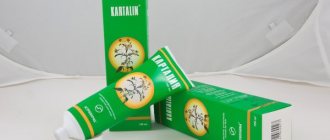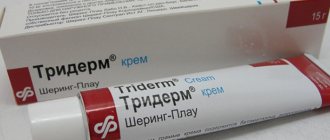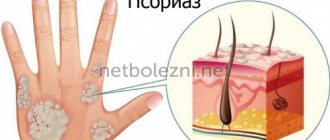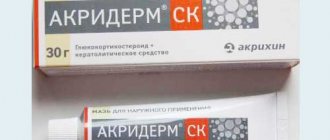Pharmacological properties of the drug Triderm
Pharmacodynamics. The drug combines the anti-inflammatory, antipruritic and vasoconstrictor effects of betamethasone dipropionate with the broad antifungal activity of clotrimazole and the broad spectrum antibacterial activity of gentamicin sulfate. Clotrimazole exhibits an antifungal effect by disrupting the synthesis of ergosterol, which is an integral part of the cell membrane of fungi. Active against Trichophyton rubrum, Trichophyton mentagrophytes, Epidermophyton floccosum, Microsporum canis, Candida albicans, Malassezia furtur (Pityrosporum obiculare) . Gentamicin is a broad-spectrum antibiotic from the aminoglycoside group. Acts bactericidal, providing highly effective local treatment of primary and secondary bacterial skin infections. Active against gram-negative bacteria: Pseudomonas aeruginosa, Aerobacter aerogenes, Escherichia coli, Proteus vulgaris and Klebsiella pneumoniae; gram-positive bacteria: Streptococcus spp . (susceptible strains of group A β- and α-hemolytic streptococcus), Staphylococcus aureus (coagulase-positive, coagulase-negative and some penicillinase-producing strains). Pharmacokinetics. There are no data on the pharmacokinetics of the drug.
Gel and ointment - difference in shelf life
Expiration dates are usually given for sealed medications. As a rule, manufacturers write how long a substance can be stored unopened. In general, ointment-based preparations last longer than gel-based preparations because the fats they contain prevent drying out.
Store medications as recommended by the manufacturer.
When storing ointment, pay attention to the manufacturer's recommendations. In the refrigerator, the medicine can harden, and at a crucial moment you simply cannot get it out of the tube.
Gel-like preparations are more convenient to use than ointment-like preparations with a similar effect, and therefore cost a little more.
Indications for use of the drug Triderm
Dermatoses amenable to treatment with GCS, if suspected or complicated by a secondary infection caused by microorganisms sensitive to the components of the drug. Superficial fungal skin diseases caused by dermatophytes and yeast fungi (mycosis of the feet, athlete's foot, pityriasis versicolor and other fungal infections of smooth skin), acute inflammatory and chronic skin diseases, complicated by bacterial and/or fungal infection, caused by pathogens sensitive to the drug.
Gel or ointment – which is better in emergency situations?
The gel is absorbed much faster than ointment. Therefore, in a situation where you urgently need to relieve pain, for example, a joint, it acts faster. If you need to provide a longer analgesic effect, relieve inflammation, ointment is preferable.
In addition to the duration of action, the list of ways in which an ointment differs from a gel includes the ability to adhere to the surfaces being treated. Gel-like medications adhere better to wet, wet surfaces, from which ointment-like medications simply slide off.
In general, ointment can penetrate deeper than gel. However, some gel preparations (for example, Traumeel) contain additives that ensure deep penetration of the main active ingredient. Then the difference between gel, cream and ointment is insignificant.
Gels and creams act faster, ointments last longer.
Side effects of the drug Triderm
Adverse reactions during treatment with Triderm are rare. Local reactions: burning sensation, erythema, exudation, pigmentation disorders (hypopigmentation) and itching. The following adverse reactions may also be caused by topical use of betamethasone (especially when using occlusive dressings): burning sensation, itching, irritation, dry skin, folliculitis, hypertrichosis, acne, hypopigmentation, perioral dermatitis, allergic contact dermatitis, skin maceration, development of secondary resistant flora, skin atrophy, stretch marks, prickly heat. Adverse reactions that may be caused by the use of clotrimazole: erythema, burning sensation, blistering, skin peeling, local swelling, itching, urticaria, general skin irritation. Adverse reactions that may be caused by the use of gentamicin: hyperemia, itching (usually do not require discontinuation of treatment).
Gel or cream – which is better to use for cosmetic purposes?
Cosmetics for hands, face and body are also made in the form of gels and creams.
- Cosmetic gel consists of 75−85% water. The remaining 15−25% are microparticles with the ability to retain moisture and other special properties. The high water content allows gel-like products to be easily absorbed into the skin, perfectly moisturize it, and avoid the formation of an unpleasant greasy film. They are recommended for young, combination, oily and problematic skin.
- Creams contain much less water than gel products. But they contain a lot of oils that provide different effects: nutrition, whitening, smoothing out fine wrinkles, etc. Creamy products are suitable for mature, dry and combination skin. They often leave an oily sheen and may not be completely absorbed. It is dangerous to apply them to problem skin - fats can clog pores and provoke even greater inflammation.
Problem skin loves gel, while normal skin loves cream.
The main difference between gel and ointment and cream is the time of use: gel-like substances are best used in the morning and afternoon, and cream-like substances are best used before bed. There are day creams, which are similar in structure to a gel, and night creams, which are more like an ointment.
Special instructions for the use of the drug Triderm
Triderm cannot be used as an ophthalmic agent. Long-term local use of antibiotics can sometimes lead to the growth of resistant microflora. In this case, as well as if irritation, sensitization or superinfection develops during the use of Triderm, treatment should be stopped and appropriate therapy should be prescribed. Cross-allergic reactions with aminoglycoside antibiotics have been observed. Any side effects with the use of systemic corticosteroids, including suppression of the function of the adrenal cortex, may also be observed with local use of corticosteroids, mainly in children. Systemic absorption of GCS or gentamicin when applied topically is higher if the product is applied over a large surface of the body or when using occlusive dressings, especially with prolonged use or the presence of skin cracks. It is necessary to avoid applying gentamicin to open wounds or damaged areas of the skin, since in such cases the risk of side effects observed with its systemic use increases. In such cases, the necessary preventive measures should be followed, especially when treating children. With long-term use of the drug, its withdrawal should be carried out gradually. Long-term use of gentamicin is not recommended. Use in children. In children, signs of suppression of the hypothalamic-pituitary-adrenal system and the appearance of external side effects under the influence of topical use of GCS are likely to occur more frequently than in adults, which is associated with greater absorption of the drug due to the large ratio of skin surface area to body weight. Children receiving treatment with local corticosteroids may experience suppression of the hypothalamic-pituitary-adrenal axis, Cushing's syndrome, growth retardation, insufficient weight gain and increased intracranial pressure. Manifestations of adrenal suppression in children: low plasma cortisol levels and lack of response to ACTH stimulation. An increase in intracranial pressure is manifested by protrusion of the fontanelle, headache, and swelling of the optic discs. Use during pregnancy and lactation. The safety of using local corticosteroids during pregnancy has not been proven, therefore the prescription of this group of drugs during pregnancy is justified only when the potential benefit to the woman outweighs the potential risk to the fetus. During pregnancy, drugs in this group should not be used in high doses or for a long time. It is not clear whether local use of GCS due to systemic absorption can cause their appearance in breast milk. The decision to stop breastfeeding or discontinue use of the drug should be made taking into account the need for the drug for the mother.
General information
The medication as a whole is focused on combating microorganisms in the form of fungi and bacteria and relieving inflammation. It is active in case of primary skin lesions and in case of secondary infection that has developed against the background of an existing disease. This medicine is prescribed for eczema, varieties of lichen, inguinal mycoses, allergic dermatitis and other pathologies.
The drug is hormonal. It is used only for medicinal purposes, but not for prophylaxis, since it has a strong effect. Both forms of the medical product are available in tubes. The dosage is usually 15 g. Triderm cream is sold in this form:
Cream "Triderm"
And this is Triderm ointment:
Triderm ointment
Triderm drug overdose, symptoms and treatment
With prolonged or excessive use of local corticosteroids, suppression of the pituitary-adrenal system is possible with the development of secondary adrenal insufficiency and the appearance of symptoms of hypercortisolism, including Cushing's syndrome. The use of clotrimazole under an occlusive dressing for 6 hours did not lead to the development of overdose symptoms. An overdose of gentamicin when applied topically is practically impossible. Treatment. Prescribe appropriate symptomatic therapy. Acute symptoms of hypercortisolism are usually reversible. If necessary, electrolyte balance should be corrected. In case of chronic toxic effects, gradual withdrawal of GCS is recommended. If excessive growth of microorganisms occurs, the use of Triderm should be discontinued and adequate therapy should be prescribed.
Is it possible to replace cream-type medications with ointment-type ones and vice versa?
What is better, ointment or cream, is decided by the doctor in each specific case. When it is not possible to obtain the required dosage form, the ointment can be replaced with cream. Replacement is possible in cases where the dosage of the active substance in the creamy medicine is the same or less than in the ointment. If the dosage is less, the cream will need to be applied more often (the number of additional procedures must be calculated in advance).
You cannot use ointment instead of cream. It is absorbed much deeper, so it can affect the “wrong” areas (for example, with a strong inflammatory process).
When replacing ointment with cream, pay attention to the concentration of the active substance.
Do not use different dosage forms at the same time. When mixed, their components may not provide the same effect as desired. If your treatment plan includes different medications and you are deciding whether to apply an ointment or a gel first, start with the gel-like substance. When it is completely absorbed and its expiration date has passed (usually 2-4 hours), clean the treated surface from the film as much as possible, then lubricate it with ointment. This is also true for creams that should be used before ointments.







